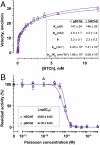Plant-derived human butyrylcholinesterase, but not an organophosphorous-compound hydrolyzing variant thereof, protects rodents against nerve agents
- PMID: 21059932
- PMCID: PMC2996644
- DOI: 10.1073/pnas.1009021107
Plant-derived human butyrylcholinesterase, but not an organophosphorous-compound hydrolyzing variant thereof, protects rodents against nerve agents
Abstract
The concept of using cholinesterase bioscavengers for prophylaxis against organophosphorous nerve agents and pesticides has progressed from the bench to clinical trial. However, the supply of the native human proteins is either limited (e.g., plasma-derived butyrylcholinesterase and erythrocytic acetylcholinesterase) or nonexisting (synaptic acetylcholinesterase). Here we identify a unique form of recombinant human butyrylcholinesterase that mimics the native enzyme assembly into tetramers; this form provides extended effective pharmacokinetics that is significantly enhanced by polyethylene glycol conjugation. We further demonstrate that this enzyme (but not a G117H/E197Q organophosphorus acid anhydride hydrolase catalytic variant) can prevent morbidity and mortality associated with organophosphorous nerve agent and pesticide exposure of animal subjects of two model species.
Conflict of interest statement
The authors declare no conflict of interest.
Figures





Similar articles
-
Prophylaxis and post-exposure treatment of intoxications caused by nerve agents and organophosphorus pesticides.Mini Rev Med Chem. 2013 Dec;13(14):2102-15. doi: 10.2174/13895575113136660108. Mini Rev Med Chem. 2013. PMID: 24195661
-
In search of a catalytic bioscavenger for the prophylaxis of nerve agent toxicity.Chem Biol Interact. 2010 Sep 6;187(1-3):349-54. doi: 10.1016/j.cbi.2010.02.021. Epub 2010 Feb 20. Chem Biol Interact. 2010. PMID: 20176006
-
Progress in the development of enzyme-based nerve agent bioscavengers.Chem Biol Interact. 2013 Dec 5;206(3):536-44. doi: 10.1016/j.cbi.2013.06.012. Epub 2013 Jun 26. Chem Biol Interact. 2013. PMID: 23811386 Review.
-
Organophosphates, serine esterase inhibition, and modeling of organophosphate toxicity.Toxicol Sci. 2004 Feb;77(2):185-7. doi: 10.1093/toxsci/kfh060. Toxicol Sci. 2004. PMID: 14992203
-
Neurotoxic disorders of organophosphorus compounds and their managements.Arch Iran Med. 2008 Jan;11(1):65-89. Arch Iran Med. 2008. PMID: 18154426 Review.
Cited by
-
Pulmonary delivery of an aerosolized recombinant human butyrylcholinesterase pretreatment protects against aerosolized paraoxon in macaques.Chem Biol Interact. 2013 Mar 25;203(1):167-71. doi: 10.1016/j.cbi.2012.11.004. Epub 2012 Nov 21. Chem Biol Interact. 2013. PMID: 23178380 Free PMC article.
-
Bacterial Expression of Human Butyrylcholinesterase as a Tool for Nerve Agent Bioscavengers Development.Molecules. 2017 Oct 27;22(11):1828. doi: 10.3390/molecules22111828. Molecules. 2017. PMID: 29077024 Free PMC article.
-
Chemical polysialylation of human recombinant butyrylcholinesterase delivers a long-acting bioscavenger for nerve agents in vivo.Proc Natl Acad Sci U S A. 2013 Jan 22;110(4):1243-8. doi: 10.1073/pnas.1211118110. Epub 2013 Jan 7. Proc Natl Acad Sci U S A. 2013. PMID: 23297221 Free PMC article.
-
Expression of human butyrylcholinesterase with an engineered glycosylation profile resembling the plasma-derived orthologue.Biotechnol J. 2014 Apr;9(4):501-10. doi: 10.1002/biot.201300229. Epub 2013 Nov 8. Biotechnol J. 2014. PMID: 24130173 Free PMC article.
-
Plant expression of cocaine hydrolase-Fc fusion protein for treatment of cocaine abuse.BMC Biotechnol. 2016 Oct 19;16(1):72. doi: 10.1186/s12896-016-0302-9. BMC Biotechnol. 2016. PMID: 27756365 Free PMC article.
References
-
- La Du BN, Lockridge O. Molecular biology of human serum cholinesterase. Fed Proc. 1986;45:2965–2969. - PubMed
-
- Arpagaus M, et al. Use of the polymerase chain reaction for homology probing of butyrylcholinesterase from several vertebrates. J Biol Chem. 1991;266:6966–6974. - PubMed
-
- Ashani Y, et al. Butyrylcholinesterase and acetylcholinesterase prophylaxis against soman poisoning in mice. Biochem Pharmacol. 1991;41:37–41. - PubMed
-
- Masson P, et al. Butyrylcholinesterase-catalysed hydrolysis of aspirin, a negatively charged ester, and aspirin-related neutral esters. Biochim Biophys Acta. 1998;1387:41–52. - PubMed
-
- Koetzner L, Woods JH. Characterization of butyrylcholinesterase antagonism of cocaine-induced hyperactivity. Drug Metab Dispos. 2002;30:716–723. - PubMed
Publication types
MeSH terms
Substances
Grants and funding
LinkOut - more resources
Full Text Sources
Other Literature Sources
Medical
Molecular Biology Databases

